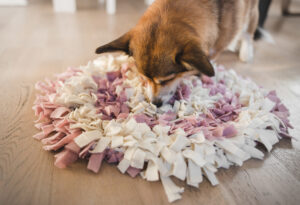 Taking walks and playing in the backyard are great opportunities for exercise, but indoor enrichment activities can go the extra mile to help transform a bored, destructive dog into a happier, calmer one.
Taking walks and playing in the backyard are great opportunities for exercise, but indoor enrichment activities can go the extra mile to help transform a bored, destructive dog into a happier, calmer one.
As a dog trainer, you know the value of offering mental stimulation inside the home to keep dogs engaged and happy–especially if they are left alone for several hours a day. Indoor enrichment is all about providing a client’s dog with a stimulating environment inside the home. Enrichment can include things like puzzle toys, interactive feeding games, and even scent work activities.
6 ways to nudge clients toward creating an enriching indoor environment
- Highlight the benefits. Start by explaining the advantages of offering enrichment inside as well as outside the home. Explain that the goal is to keep their dog mentally engaged and challenged, which helps prevent boredom and destructive behaviors. Just like we humans enjoy hobbies, puzzles, and other mental enrichment activities, indoor enrichment for our dogs can help reduce their anxiety and improve overall behavior.
- Offer recommendations. As a dog trainer, you likely have some favorite indoor enrichment products and activities. Share these with your clients and explain why you recommend them. This can help make it easier for owners to get started.
- Provide resources. Consider creating a list of indoor enrichment resources for your clients. This could include links to your favorite products, DIY instructions for making their own enrichment toys, and even training videos.
- Show, don’t tell. Sometimes the best way to encourage someone to try something new is to show them how it’s done. Consider filming a video of yourself working with your own dog on an indoor enrichment activity. Seeing it in action can be a powerful motivator for your clients. And when their own dog figures out a puzzle toy, for example, clients are often amazed and delighted!
- Share one of Victoria’s videos! Here’s one on mental enrichment with toys and games.
- Keep it fun! Finally, it’s important for clients to keep things fun and lighthearted with their pets. Indoor enrichment should be an enjoyable and engaging activity for both dogs and their owners. Encourage your clients to experiment with different activities and their own ideas.
Your clients may need a little encouragement to get the creative juices flowing and add more than an evening game of tug or training homework to their dog’s enrichment schedule. So how can you encourage dog owners to add enrichment inside their home?
7 DIY enrichment activities to suggest
- Puzzle toys. There are many different types of puzzle toys available to keep your dog mentally engaged. These toys usually involve hiding treats or kibble inside a toy that the dog must figure out how to access.
- Snuffle mats. A snuffle mat is a floor mat with protruding fabric strips or other materials that are used to hide treats or kibble. The dog then sniffs around and uses their nose to find the hidden goodies. Clients can either purchase a pre-made snuffle mat or find an online tutorial and make one themselves.
- Interactive feeding games. Similar to puzzle toys, interactive feeding games involve hiding food or treats in a toy or behind or under a container. The dog must then figure out how to access the food by pushing, pulling, or manipulating the toy in some way.
- Training games. Training games are a great way to provide mental stimulation for your dog while also working on obedience and behavior. You can work on basic manners cues like sit, down, or come, or introduce more advanced tricks like high five.
- Scent work. Dogs have an incredible sense of smell, and scent work activities can be a great way to engage their noses and provide mental stimulation. You can hide treats or toys around the house for your dog to find, or even create a mini scent work course with different scents for your dog to identify.
- Indoor agility. Agility courses are usually associated with outdoor activities, but it’s possible to create a mini course inside your home as well. You can use household items like chairs, broomsticks, and blankets to create tunnels, jumps, and other obstacles for your dog to navigate.
- Playdates. Some dogs love to interact and play with other dogs. For these social dogs, playdates in your home with other like-minded dogs can provide mental stimulation and exercise. Just be sure to keep an eye out and monitor for body language to make sure it remains fun for both dogs.
Spread the joy of enrichment
If you enjoy helping clients bring out the best in their dog, the Victoria Stilwell Academy can guide your career to a new level. Learn more about our flagship Dog Trainer Course and share your enrichment successes on Facebook or shoot us an email here!



